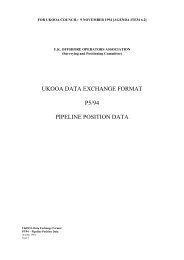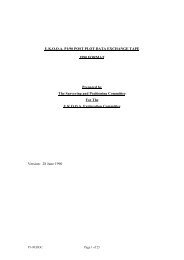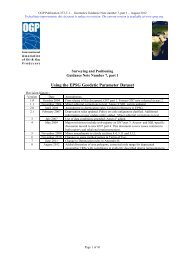1065 - OGP Surveying and Positioning Committee
1065 - OGP Surveying and Positioning Committee
1065 - OGP Surveying and Positioning Committee
Create successful ePaper yourself
Turn your PDF publications into a flip-book with our unique Google optimized e-Paper software.
_____________________________________________________________________________________________________________________Page 12If the software you are using does allow a seven-parameter shift one should be awarethat there are two opposing sign conventions for the three rotation parameters. These areconsidered to be two different transformation methods, either a Position Vectortransformation or a Co-ordinate Frame Transformation. The convention used within theGazette notice is that of the Position Vector transformation (elsewhere called the Bursa-Wolf Transformation). It is crucial that the signs <strong>and</strong> interpretation of the transformationparameters are consistent with the convention being applied by the algorithm within yourapplication. Ask your vendor to clarify his application algorithm, <strong>and</strong> use a given testpoint, such as provided in the Gazette notice, to confirm.If the software you are using does not allow a seven-parameter shift, it may be that it usesa three-parameter Molodenski transformation method. If this is the case one will NOT beable to use the seven parameter values given in the DTI Gazette notice. It isrecommended that an alternative software package be used until the user’s preferredapplication has the necessary capability.ii.iii.The Gazette notice provides defines transformation parameters between the geographicco-ordinate systems recognised for use on/around the UKCS. Applications includinggeodetic transformation data may be delivered with transformations that are inconsistentwith those recommended for UKCS. Check <strong>and</strong> change if necessary. If you have alreadyused the preset transformations <strong>and</strong> their parameters are different, consideration shouldbe given to applying the old transformation to WGS 84, <strong>and</strong> transforming the data oncemore using the transformations detailed in the Gazettal notice (annex A).To define a co-ordinate system, it is not necessary to make reference to its relationshipwith any other co-ordinate system. However, some software packages imbed thegeodetic transformation parameters between different co-ordinate systems within the coordinatesystem definitions. For such applications, the co-ordinate system definitions alsoneed to be checked <strong>and</strong> if necessary changed.If the geodetic co-ordinate system reference ETRF89 is not yet established within yoursoftware it is recommended that a new one is set-up using the parameters for ellipsoid asquoted in annex G. Its datum relationship with WGS 84 should be set with zero values.The software vendor should be approached for assistance if this is found not to bepossible.iv.If asked by a software vendor to use WGS 84 for the interim period until a new release ofthe software is given, be aware of the potential for "project amendment problems” whenthe future release arrives including ETRF89 as a separate geodetic datum.Related to this is the potential for error in automated data exchange packages/links whenmerging data files with different naming conventions for the co-ordinate systems.____________________________________________________________________________________________UKOOA Guidance Notes on use of co-ordinate systems in data management on the UKCS. November 1999






